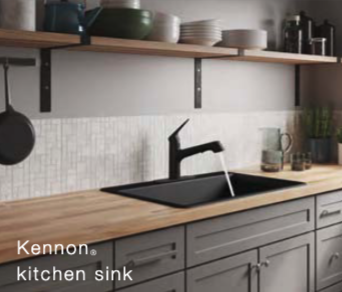Kohler: Better Planet: Environmentally Friendly Products
Originally published in Kohler's 2021 Believing in Better ESG Report
At the core of our efforts to reduce Kohler’s environmental impact is our focus on providing customers with environmentally friendly products and services. Through our Design for Environment (DfE) methodology, we design new products and services with sustainability in mind, focusing on reducing environmental impacts through all stages of the product life cycle. We designate products as Positive by Design SM internally after they go through the DfE process and have proven there can be a positive impact in one of the four key impact categories. To support sustainable innovation in our product development efforts, we also created the Innovation for Good ® incubator focused on creating new business opportunities that address some of the most pressing environmental problems related to safe water, safe sanitation, and reliable power globally.
Design for Environment
Our DfE methodology, which is applied in all Kohler businesses, is a data-driven process that enables us to understand the environmental impact of our products and rethink design aspects accordingly. We have developed a DfE strategy guide and various in-house tools for engineers that not only help to create sustainable products, but also track the resulting environmental impact reductions throughout the life cycle. DfE employs a multicriteria strategy that integrates all aspects of the product from design to supply chain and production through product use and end of life.
DfE starts with simple questions including:
- How can we make design changes with the least environmental impact?
- Can we use renewable materials without compromising product quality?
- Can we decrease the water flow rate of the product without any change in user experience?
- Can we increase the duration between maintenance intervals?
- Will using more sustainable materials impact the product design, function, or aesthetics?
As part of the DfE process, we began using life cycle inventory (LCI) modeling in 2011 to help understand the overall environmental impact of our products, highlighting opportunities to reduce the impact through material use and design. We are on track to meet our goal to complete LCI modeling in 100% of our plants that manufacture vitreous china, stainless steel, and faucets products by the end of 2022 and will be tracking DfE impacts on GHG emissions and water consumption and reporting progress going forward.
New Product Highlights
Among the new products that were developed in 2021 employing the DfE process is the KOHLER ® Maxstow medicine cabinet with defogger, which incorporates the most energyefficient defogger that Kohler makes. During the design phase, we were able to decrease the use of aluminum in the product which reduced total carbon emissions by 20%. We are also developing a budget-friendly modular platform where customers can choose the products or modular parts based on their needs.
Our packaging engineering team used the DfE process to develop the Croc Crate, a high-strength reusable/ returnable package with special interlocking clips that allow for easy inspection with no tools required for unboxing. The package uses less storage space as the volume is reduced by 87.3% and can be easily reused and/or recycled. This new packaging both improves the customer experience and decreases our materials costs and reduces our environmental footprint, as it uses 20% less material, 90% less water, and has 85% less carbon emissions.
In 2021 the DfE process was also used to develop improved packaging for the Kennon ® kitchen sink made of Neoroc ® composite material, with a goal of reducing damage incurred during shipping. The packaging change added materials to meet performance requirements but the estimated damage reduction of 50% is expected to significantly lower overall environmental impacts including waste, GHG emissions, water use, and toxicity.
Creating Increased Product Transparency
We are a pioneer in providing at-scale solutions for product transparency, including supporting the climate-resilience and green building movement through Environmental Product Declarations (EPD) and third-party-verified Declare labels.
These labels communicate how a product is manufactured, what it is made of, and what its impact on the environment is, thus enabling end users to make informed decisions and aiding architects and designers in the achievement of Leadership in Energy and Environmental Design (LEED) certification.
In recent years, we have expanded our EPD offerings to material categories such as vitreous china, cast iron, acrylic, and Vikrell ® and in 2021 we added 100% of global faucet SKUs to the EPD program. Declare labels are available for products within material groups including cast iron, vitreous china, and stainless steel.
Kohler is committed to full product transparency through our partnership with the International Living Future Institute, which organizes the Living Products 50 (LP50) coalition of leading manufacturers working to ensure that healthy, high-performing building materials with full material transparency are the rule, not the exception.



